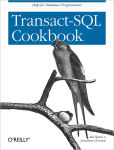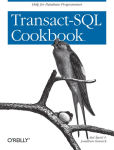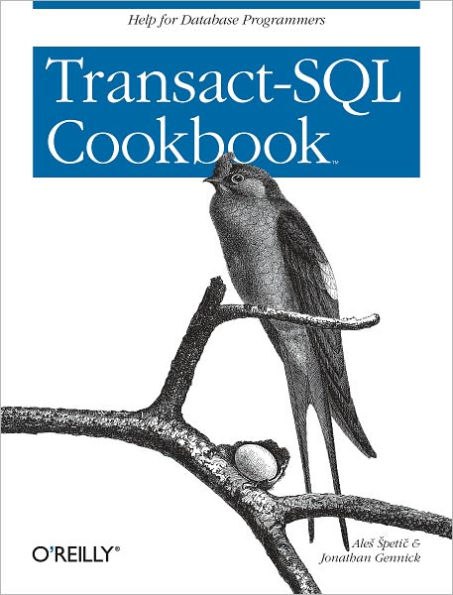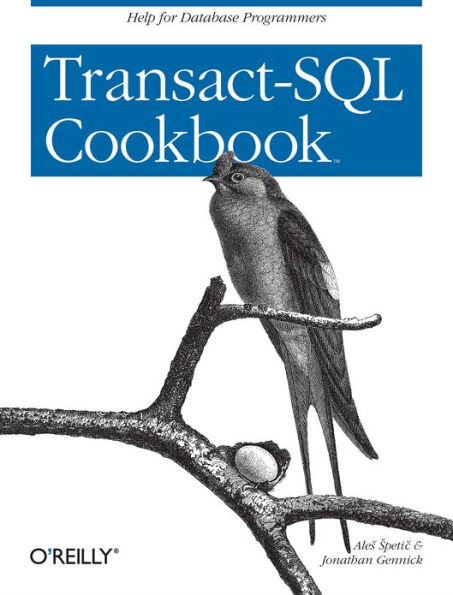This unique cookbook contains a wealth of solutions to problems that SQL programmers face all the time. The recipes inside range from how to perform simple tasks, like importing external data, to ways of handling issues that are more complicated, like set algebra. Authors Ales Spetic and Jonathan Gennick, two authorities with extensive database and SQL programming experience, include a discussion with each recipe to explain the logic and concepts underlying the solution.SQL (Structured Query Language) is the closest thing to a standard query language that currently exists, and Transact-SQL -- a full-featured programming language that dramatically extends the power of SQL -- is the procedural language of choice for both Microsoft SQL Server and Sybase SQL Server systems. The Transact-SQL Cookbook is designed so you can use the recipes directly, as a source of ideas, or as a way to learn a little more about SQL and what you can do with it. Topics covered include:
- Audit logging. In addition to recipes for implementing an audit log, this chapter also includes recipes for: improving performance where large log tables are involved; supporting multiple-languages; and simulating server push.
- Hierarchies. Recipes show you how to manipulate hierarchical data using Transact-SQL.
- Importing data. This chapter introduces concepts like normalization and recipes useful for working with imported data tables.
- Sets. Recipes demonstrate different operations, such as how to find common elements, summarize the data in a set, and find the element in a set that represents an extreme.
- Statistics. This chapter's recipes show you how to effectively use SQL for common statistical operations from means and standard deviations to weighted moving averages.
- Temporal data. Recipes demonstrate how to construct queries against time-based data.
- Data Structures. This chapter shows how to manipulate data structures like stacks, queues, matrices, and arrays.
This unique cookbook contains a wealth of solutions to problems that SQL programmers face all the time. The recipes inside range from how to perform simple tasks, like importing external data, to ways of handling issues that are more complicated, like set algebra. Authors Ales Spetic and Jonathan Gennick, two authorities with extensive database and SQL programming experience, include a discussion with each recipe to explain the logic and concepts underlying the solution.SQL (Structured Query Language) is the closest thing to a standard query language that currently exists, and Transact-SQL -- a full-featured programming language that dramatically extends the power of SQL -- is the procedural language of choice for both Microsoft SQL Server and Sybase SQL Server systems. The Transact-SQL Cookbook is designed so you can use the recipes directly, as a source of ideas, or as a way to learn a little more about SQL and what you can do with it. Topics covered include:
- Audit logging. In addition to recipes for implementing an audit log, this chapter also includes recipes for: improving performance where large log tables are involved; supporting multiple-languages; and simulating server push.
- Hierarchies. Recipes show you how to manipulate hierarchical data using Transact-SQL.
- Importing data. This chapter introduces concepts like normalization and recipes useful for working with imported data tables.
- Sets. Recipes demonstrate different operations, such as how to find common elements, summarize the data in a set, and find the element in a set that represents an extreme.
- Statistics. This chapter's recipes show you how to effectively use SQL for common statistical operations from means and standard deviations to weighted moving averages.
- Temporal data. Recipes demonstrate how to construct queries against time-based data.
- Data Structures. This chapter shows how to manipulate data structures like stacks, queues, matrices, and arrays.

Transact-SQL Cookbook: Help for Database Programmers
304
Transact-SQL Cookbook: Help for Database Programmers
304
Product Details
| ISBN-13: | 9780596552039 |
|---|---|
| Publisher: | O'Reilly Media, Incorporated |
| Publication date: | 03/19/2002 |
| Sold by: | Barnes & Noble |
| Format: | eBook |
| Pages: | 304 |
| File size: | 3 MB |



